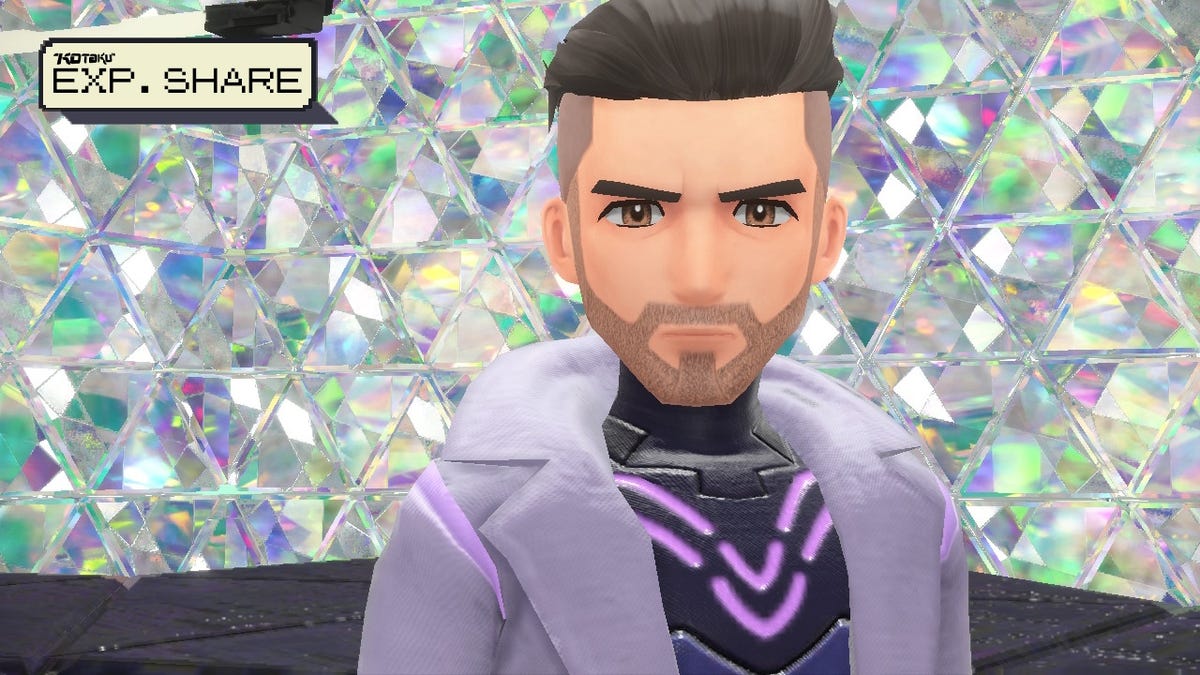Pokémon Scarlet and Violet are all about finding freedom in their open world. This is as true mechanically as it is thematically, as the pair of Switch RPGs let you freely explore the Paldea region in search of your own “treasure.” They posit that the Pokémon world is full of possibilities and that it can mean something different to anyone. You can become the region’s champion, help the students of Paldea’s central academy with their personal problems, or you can just fuck off into the wilderness and capture every critter you can find. But narratively, it also asks: what if all that ambition and freedom is left unchecked? Scarlet and Violet’s finale takes this question to its darkest, most tragic conclusion, and as we near the release of its final DLC, let’s look back at what made the final hours of these messy games so spectacular.
Buy Pokémon Scarlet: Amazon | Best Buy | GameStop
Buy Pokémon Violet: Amazon | Best Buy | GameStop
In most Pokémon games, the professor is an opening staple for your adventure. They’re usually the person who gives you your starter, tells you to catch ‘em all and fill up your Pokédex, and hints at new, underlying mysteries of whatever region the game is set in. In Scarlet and Violet, the professor is much more enigmatic. Professor Sada and Turo, who appear in Scarlet and Violet respectively, aren’t really part of your journey at all. They aren’t there to greet you when you boot up the game, they only ever talk to you by video call, and even when they do talk to you, it’s just to ask you to investigate something above ground while they toil away at something in the Great Crater at the center of the Paldea region.
This distance is apparently pretty normal, as even Arven, the professor’s son, hasn’t had much of a relationship with them in a long time. Scarlet and Violet aren’t afraid to sit with the trauma their young characters experience due to the neglect of the adults around them. The Team Star plotline explores the cycles of bullying within the Paldean school as adults fail to step in and help, and Arven’s relationship with the professor (or lack thereof) is the familial realization of the same problem. Even the gym leader storyline highlights how adult characters cannot count on their own leadership, with characters like the exhausted workaholic Larry highlighting that the adults in the room are so enamored by their own “treasure” that they lose sight of their community.

Scarlet and Violet touch on all these ideas in each of their branching storylines, but they all converge in one place: Area Zero. At the behest of the professor, the player, alongside the friends they’ve met throughout their journey, heads down to the Great Crater of Paldea to help stop some mystery problem. That all sounds standard enough, but I wasn’t prepared for what would come next.
When I first played Violet, even the opening cutscene of Area Zero felt markedly different from everything that came before. First, rather than all the friends I’d made across Paldea existing on islands in different, self-contained storylines, they all converge to fight whatever awaits us in the depths of the region. Arven wants to confront his father, Nemona has impressive battling skills to help fight whatever threats lurk below, and Penny is our tech support.

Welcome to Exp. Share, Kotaku’s Pokémon column in which we dive deep to explore notable characters, urban legends, communities, and just plain weird quirks from throughout the Pokémon franchise.
Pokémon games are full of memorable characters, but because your player character tends to be pretty independent, you don’t spend a lot of time feeling like you have a real RPG cast with dynamics and relationships to explore. Traveling down the Great Crater of Paldea is a communal moment, though it is slightly undermined by Pokémon’s insistence on not adding voice acting to its main games. You have to read dialogue as fleeting subtitles while you run around, battling powerful wild Pokémon, but Penny, Arven, and Nemona form a pretty compelling party. Penny and Arven’s seriousness runs against Nemona’s carefree nature, even as the grim reality of what’s happened in Area Zero becomes more clear.
As the group travels down Area Zero (all to the tune of the gorgeous, choir-driven theme composed by Undertale developer Toby Fox), they pass through long-abandoned labs, reading scribbled notes in the professor’s journals that illustrate a genius descending into madness just as these kids descend into the depths of the Paldea region. There are references to their desire to see what Pokémon would look like in the far-flung future for Turo, or the prehistoric past for Sada, and the revelation that they created a working time machine to finally realize their dream of Pokémon of different eras co-existing through time.
These futuristic and ancient Pokémon are called Paradox Pokémon, and seem to be past or future relatives of the Pokémon we know. In Scarlet, the first of these the team comes across is Scream Tail, a long-haired, fanged version of a Jigglypuff. In Violet, the group meets a robotic relative of Delibird known only as Iron Bundle. It turns out, the professor has been slinging Master Balls, which are guaranteed to capture any Pokémon they come in contact with, into the time machine and bringing old and new Pokémon into the present.
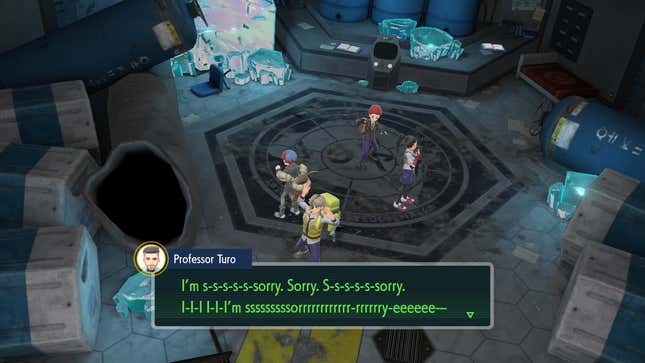
The problem is, because these Pokémon haven’t evolved for Paldea’s current ecosystem, they have the same effect as an invasive species, and thus, were kept in Area Zero to avoid causing harm to the people and Pokémon of the region. But if they were such a danger, why are they still here? Why didn’t the professor send them back to the point in time where they came from? These are the uneasy questions Scarlet and Violet make you sit with as you discover more of these displaced Pokémon while trying to reach the professor’s base at the bottom of the crater. But on the way down, you find one final laboratory that has clearly been destroyed in what seems to be an intense battle. And as the professor’s calls to your team become more distorted, erratic, and perhaps…robotic, Scarlet and Violet’s mysteries become more than alluring, they become haunting.
At the bottom of Area Zero, we meet the professor, but it’s not actually them. It’s a robot powered by an AI copy of them that has been maintaining this underground lab ever since the real professor was mauled by a legendary Paradox Pokémon that still lives in Area Zero. Ultimately, the professor’s downfall was borne of the same freedom to pursue one’s own passions that Scarlet and Violet are built upon. As their journals describe, the professor’s partner left them and Arven (it’s heavily implied that whichever professor doesn’t appear in the game you’re playing is still Arven’s absentee parent), and the only person they had to check their ambition was a digital copy of themself. But now, with the professor gone, their ghost-in-the-machine AI has sought out help to end the wanton destruction left behind in the wake of their death. They ask the player to shut down the time machine so no more Paradox Pokémon can threaten Paldea.
Even before we get into the “how” of this revelation and all its ramifications, we have to talk about how these scenes are presented. They’re all delivered with a deafening silence as the music fades away and the only sound left is the elevator bringing you and the AI professor to the lowest point in the lab. You can ask a few questions about what happened to the professor, and sure, a little bit of the dialogue seems hand-holdy, as if designed to help any kids who might not know what artificial intelligence is, but the implications about who the professor was in life are both poignant and also pretty damning.
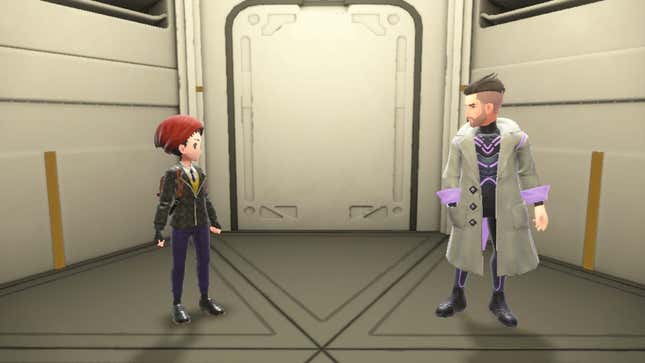
The AI has the professor’s memories, but doesn’t share their view that their dream of seeing time-displaced Pokémon was worth the potential destruction. They cannot fathom why the professor would have felt so strongly as to disregard the safety of everyone, even their own son, to see this dream achieved. But as part of the professor’s safety net protocols, they are unable to stop it alone. This is why we’re here, but even in death, the professor’s fixation with their dream lives on in the machine they’ve left behind.
This leads us to what is easily the best moment in all of Scarlet and Violet, and perhaps one of the best moments in the Pokémon franchise’s history. The AI explains that in order to shut down the time machine, we must battle them, as any attempt to turn off the machine will result in the activation of all its defensive protocols, including the AI itself. We reach the time machine, which is encased in a Tera Crystal-like dome, and when we initiate the shutdown, the AI pleads one final time that we must defeat them before the professor’s programming takes over.
Then we get into some Yoko Taro-ass shit. The AI’s robot ascends to a giant platform, towering over the player as the professor’s personality completely overwrites their AI copy. Their dialogue boxes become distorted, with broken text and their name tag switching from “AI Turo” to “Professor Turo,” so you know who is speaking to you from beyond the grave. Even while Pokémon games have refused to adopt cinematic production values like voice acting, Scarlet and Violet use their text-based storytelling and sporadic, malfunctioning animations as best they can to illustrate that the professor’s mad scientist mind is fighting you, even if they’re not alive to do it themselves.
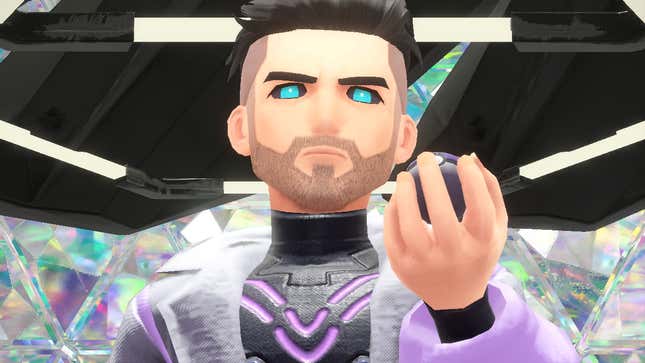
The battle, set to the incredible final fight theme, tears down any good faith view you can have of the character, as they speak down to you, dismissing your small-minded views and your Pokémon battling skills. The Professor is supposed to be a safe place for you to retreat to in a Pokémon game. Scarlet and Violet do more than flip this on its head; they eviscerate any notion of it.
Defeating the professor’s synthetic ghost saves the day, but even as the climactic fight comes to a close, Scarlet and Violet hammer home how we got here. The AI laments that it had to watch you and your friends explore the Paldea region in search of your own “treasures” while they were stuck maintaining a mad scientist’s in Area Zero. But even as they’ve managed to make a hard break from the cataclysm the professor wanted, they still have bits and pieces of their creator’s hopes in their programming. They attempt to tell Arven that his parent loved him, despite the distance, and then use the time machine to journey to the distant past or future. It underlines how the Pokémon world is full of possibilities to be sought out, but without the companionship you’ve found in your journey, that ambition can have catastrophic consequences.
In the past few years, Pokémon games have started flexing their narrative muscles in a way they never really had before. Make no mistake, the anime (especially the limited series runs you can find on the franchise’s YouTube channel), manga, and films have always delved into the terrifying possibilities of the universe. But there’s often an idea that Pokémon can’t be “for adults” because it’s too busy being for children. And while that premise is, in and of itself, flawed, because adults can relate to themes of friendship, teamwork, and community as much as any kid, the actual lore is becoming more of a focal point of each game, rather than something you make a detour to see before getting back to your eight badges.
Scarlet and Violet are so willing to just go for it that it illustrates the difference between something that merely entertains a child and something that can change their life. If I had played through the Professor Turo boss fight as a kid just starting out my Pokémon journey, it would’ve completely changed how I viewed its world, giving me so much to think about and consider rather than making me feel like I had to use my imagination to expand it beyond the boundaries of the games.
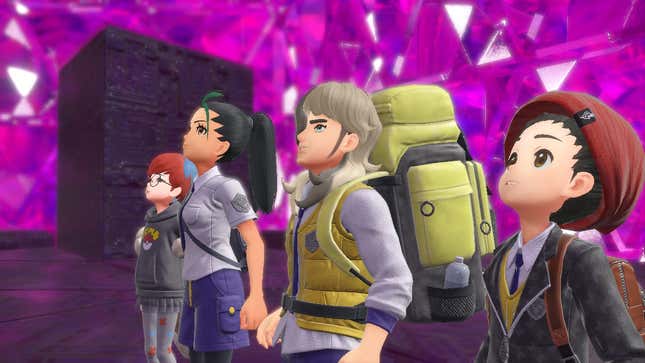
Pokémon Legends: Arceus, Detective Pikachu, and Scarlet and Violet have told some of the best stories the series has ever dared to tell, and the exciting part of this story is that it’s not quite done. As the title The Hidden Treasure of Area Zero implies, Scarlet and Violet’s two-part DLC has already hinted that we’ll finally uncover the mysteries of Paradox Pokémon and how the professor may have been involved in some much deeper shit than they even realized. The Teal Mask DLC wasn’t great, but it did lay the foundation for further exploration of what happened in Area Zero in The Indigo Disk on December 14.
Even while The Teal Mask felt half-baked, it still had complex character relationships that I’m interested to see through, but more than anything, especially after writing this, I’m excited to finally see the conclusion of what feels like it could be Pokémon’s best story ever. Hopefully, it lives up to what Scarlet and Violet laid down.
Buy Pokémon Scarlet: Amazon | Best Buy | GameStop
Buy Pokémon Violet: Amazon | Best Buy | GameStop
.

Laura Adams is a tech enthusiast residing in the UK. Her articles cover the latest technological innovations, from AI to consumer gadgets, providing readers with a glimpse into the future of technology.

